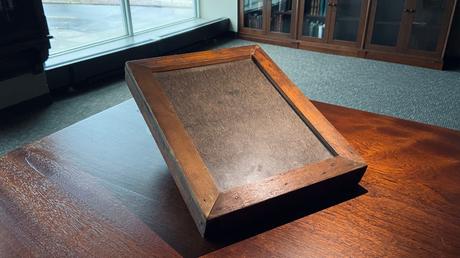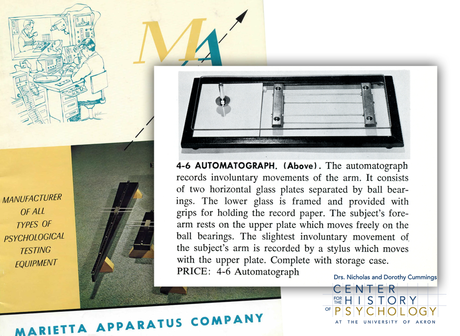– contributed by Tony Pankuch.
Our collections contain a range of unusual artifacts, but one that might surprise you is that we have our very own Ouija Board. Ouija Boards and similar tools have a long history in the field of psychology.
We’d like to share a few fun facts for the Halloween season.
 Ouija Board. Artifacts collection, Archives of the History of American Psychology, The Cummings Center for the History of Psychology, The University of Akron.
Ouija Board. Artifacts collection, Archives of the History of American Psychology, The Cummings Center for the History of Psychology, The University of Akron.Most may associate the Ouija Board with the supernatural, but it has been used as a tool for the psychological study of the unconscious mind. In 1957, Frank X. Barron included the Ouija Board in a battery of tests used to study well-known creative writers. Barron’s research notes include detailed descriptions of his subjects’ interactions with the Ouija Board:
 Research notes, 1957. Box M5426, Folder 13, Frank X. Barron papers, Archives of the History of American Psychology, The Cummings Center for the History of Psychology, The University of Akron.
Research notes, 1957. Box M5426, Folder 13, Frank X. Barron papers, Archives of the History of American Psychology, The Cummings Center for the History of Psychology, The University of Akron.[redacted] tried to recall the name of a man who had been a school teacher of his. He was not clear about what grade he had had this teacher in, nor was he able to remember his name, though he could visualize the person quite well. The Ouija board traced the following path:
Q P O 1 P T C Q U V W 9 8
When the table paused over 8, [redacted] with some excitement interrupted to report that something extraordinary had happened. He was aware that the pointer had rested over W and then moved to 8. When it came to 8 he remembered all of a sudden that the teacher whose name he was trying to recall had been his teacher in the 8th grade, and it was at the same moment he remembered that his teacher’s name began with W; was, indeed, Weaver.
Barron wasn’t looking to have his subjects communicate with spirits—rather, he and other psychologists who used the Ouija Board hoped that the words and patterns created by their subjects’ hand movements might reflect their unconscious thoughts, feelings, or desires.
Similar to the Ouija Board, this Spirit Writing Board, donated to the Cummings Center by Hobart-William Smith College, was used by researchers to produce “automatic writing”—writing which allegedly comes from the unconscious thoughts of the writer.
 Spirit Writing Board. Artifacts collection, Archives of the History of American Psychology, The Cummings Center for the History of Psychology, The University of Akron.
Spirit Writing Board. Artifacts collection, Archives of the History of American Psychology, The Cummings Center for the History of Psychology, The University of Akron.Then there’s the Automatograph. Historian Arthur Blumenthal described the Automatograph as a “scientific-instrument version of the Ouija board.” It doesn’t record writing or messages, but its free moving ball bearings make it ideal for documenting the slightest involuntary movements.
 Marietta Apparatus Company Catalog, undated. Instruments, Apparatus, and Other Manuals and Catalogs, Archives of the History of American Psychology, The Cummings Center for the History of Psychology, The University of Akron.
Marietta Apparatus Company Catalog, undated. Instruments, Apparatus, and Other Manuals and Catalogs, Archives of the History of American Psychology, The Cummings Center for the History of Psychology, The University of Akron.The automatograph records involuntary movements of the arm. It consists of two horizontal glass plates separated by ball bearings. The lower glass is framed and provided with grips for holding the record paper. The subject’s forearm rests on the paper which moves freely on the ball bearings. The slightest involuntary movement of the subject’s arm is recorded by a stylus which moves with the upper plate. Complete with storage case.
The Automatograph was developed by psychologist Joseph Jastrow in the mid-19th century. Jastrow was an strong opponent of spiritualism, and his Automatograph was designed to debunk spiritualism by documenting a psychological, rather than spiritual, basis for unconscious movements.
So, while the Ouija Board may initially seem disconnected from psychological science, the concept of automatic movement—either by spiritual intervention or unconscious impulse—has fascinated psychologists for well over a century. Thus explaining its place in the Archives of the History of American Psychology.
